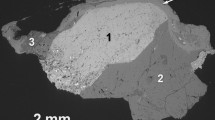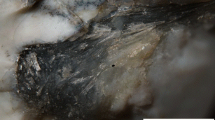Abstract
Alloriite, a new mineral species, has been found in volcanic ejecta at Mt. Cavalluccio (Campagnano municipality, Roma province, Latium region, Italy) together with sanidine, biotite, andradite, and apatite. The mineral is named in honor of Roberto Allori (b. 1933), an amateur mineralogist and prominent mineral collector who carried out extensive and detailed field mineralogical investigations of volcanoes in the Latium region. Alloriite occurs as short prismatic and tabular crystals up to 1.5 × 2 mm in size. The mineral is colorless, transparent, with a white streak and vitreous luster. Alloriite is not fluorescent and brittle; the Mohs’ hardness is 5. The cleavage is imperfect parallel to {10\(\overline 1 \)0}. The density measured with equilibration in heavy liquids is 2.35g/cm3 and calculated density (D calc) is 2.358 g/cm3 (on the basis of X-ray single-crystal data) and 2.333 g/cm3 (from X-ray powder data). Alloriite is optically uniaxial, positive, ω = 1.497(2), and ɛ = 1.499(2). The infrared spectrum is given. The chemical composition (electron microprobe, H2O determined using the Penfield method, CO2, with selective sorption, wt %) is: 13.55 Na2O, 6.67 K2O, 6.23 CaO, 26.45 Al2O3, 34.64 SiO2, 8.92 SO3, 0.37 Cl, 2.1 H2O, 0.7 CO2, 0.08-O = Cl2, where the total is 99.55. The empirical formula (Z = 1) is Na19.16K6.21Ca4.87(Si25.26Al22.74O96)(SO4)4.88(CO3)0.70Cl0.46(OH)0.76 · 4.73H2O. The simplified formula (taking into account the structural data, Z = 4) is: [Na(H2O)][Na4K1.5(SO4)] · [Ca(OH,Cl)0.5](Si6Al6O24). The crystal structure has been studied (R = 0.052). Alloriite is trigonal, the space group is P31c; the unit-cell dimensions are a = 12.892(3), c = 21.340(5) Å, and V = 3071.6(15) Å3. The crystal structure of alloriite is based on the same tetrahedral framework as that of afghanite. In contrast to afghanite containing clusters [Ca-Cl]+ and chains ...Ca-Cl-Ca-Cl..., the new mineral contains clusters [Na-H2O]+ and chains ...Na-H2O-Na-H2O.... The strongest reflections in the X-ray powder diffraction pattern [d, Å (I, %)(hkl)] are: 11.3(70)(100), 4.85(90)(104), 3.76(80)(300), 3.68(70)(301), 3.33(100)(214), and 2.694(70)(314, 008). The type material of alloriite is deposited in the Fersman Mineralogical Museum, Russian Academy of Sciences, Moscow. The registration number is 3459/1.
Similar content being viewed by others
References
P. Ballirano, A. Maras, and P. R. Buseck, “Crystal Chemistry and IR Spectroscopy of Cl-and SO4-Bearing Cancrinite-Like Minerals,” Am. Mineral. 81, 1003–1012 (1996).
P. Ballirano, A. Maras, P. R. Buseck, et al., “Improved Powder X-Ray Data for Cancrinites: I. Afghanite,” Powder Diffraction 9(1), 68–73 (1994).
P. Ballirano, E. Bonaccorsi, A. Maras, and S. Merlino, “Crystal Structure of Afghanite, the Eightlayer Member of the Cancrinite Group: Evidence for Long-Range Si, Al Ordering,” Eur. J. Mineral. 9, 21–30 (1997).
P. Bariand, F. Cesbron, and R. Giraud, “Une Nouvelle Espéce Minerale: l’Afghanite de Sar-e-Sang, Badakhshan, Afghanistan. Comparison Avec les Minéraux du Groupe de la Cancrinite,” Bull. Soc. Franc. Miner. Gristallogr 91, 34–42 (1968).
E. Bonaccorsi and S. Merlino, “Modular Microporous Minerals: Cancrinite-Davyne Group and C-S-H Phases,” Reviews in Mineral. and Geochem. 57, 241–290 (2005).
G. Della Ventura, F. Bellatreccia, and E. Bonaccorsi, “CO2 in Minerals of the Cancrinite-Sodalite Group: Piglianoite,” Eur. J. Mineral. 17, 847–851 (2005).
E. A. Pobedimskaya, R. K. Rastsvetaeva, L. E. Terent’eva, and A. N. Sapozhnikov, “Crystal Structure of Afghanite,” Dokl. Akad. Nauk SSSR 320(4), 882–886 (1991).
R. K. Rastsvetaeva, E. A. Pobedimskaya, L. E. Terent’eva, and A. N. Sapozhnikov, “Structural Features of Afghanite and Its Place Among Minerals of Cancrinite Group,” Kristallografiya 38(2), 94–103 (1993).
Author information
Authors and Affiliations
Corresponding author
Additional information
Original Russian Text © N.V. Chukanov, R.K. Rastsvetaeva, I.V. Pekov, A.E. Zadov, 2007, published in Zapiski Rossiiskogo Mineralogicheskogo Obshchestva, 2007, No. 1, pp. 82–89.
A new mineral alloriite and its name were accepted by the Commission on New Minerals and Mineral Names, Russian Mineralogical Society, May 8, 2006. Approved by the Commission on New Minerals and Mineral Names, International Mineralogical Association, August 2, 2006.
Rights and permissions
About this article
Cite this article
Chukanov, N.V., Rastsvetaeva, R.K., Pekov, I.V. et al. Alloriite, Na5K1.5Ca(Si6Al6O24)(SO4)(OH)0.5 · H2O, a new mineral species of the cancrinite group. Geol. Ore Deposits 49, 752–757 (2007). https://doi.org/10.1134/S1075701507080090
Received:
Issue Date:
DOI: https://doi.org/10.1134/S1075701507080090




